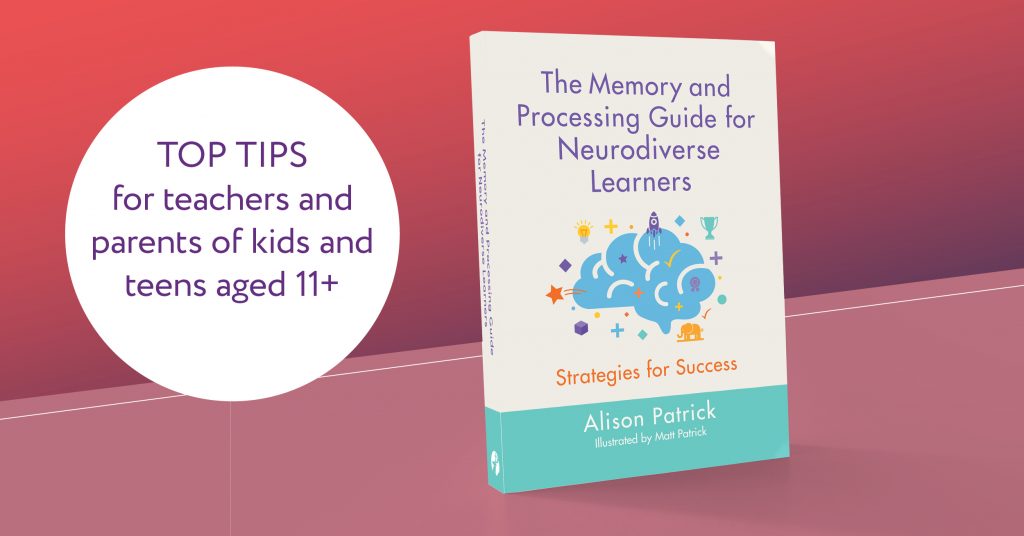
Alison Patrick, author of The Memory and Processing Guide for Neurodiverse Learners writes about her journey to identifying her own dyspraxia and ADHD
At the time I was writing The Memory and Processing Guide for Neurodiverse Learners, I was on an unexpected journey into properly understanding my own neurodiversity. I had a diagnosis of dyspraxia from an NHS neurologist in the summer of 2018. I had been referred to him with headaches but I took this to be a once in a lifetime opportunity to ask an expert about dyspraxia. When asked to perform some balancing and mimicking gestures, I couldn’t, and it was clear very quickly to the neurologist that I had dyspraxia. Brain scans showed no brain damage, so the neurologist concluded that my dyspraxia was most likely caused by a difficult birth. I was pleased to have this dyspraxia diagnosis because I wanted to understand what makes me different: why for my whole life I have struggled with physical tasks and perceptual misunderstandings.
The neurologist thought that the dyspraxia might co-occur with a weakness in memory, so he referred me to a neuropsychologist. I was just about to begin writing the executive function chapter in my book when I saw the neuropsychologist in February 2019. The result confirmed my dyspraxia, but also revealed that the dyspraxia is trumped by a weak executive function. This surprised me, although it made sense when I learned more about executive function. Executive function controls so many areas that we take for granted: concentration, impulsivity, time management, planning, organisation and task management. Working memory is a significant component of executive function, so I have a weak working memory. The neuropsychologist described me as a talented orchestra without a conductor (Brown 2005, p.10).
An educational psychologist screened me a little further to gather more history and the perspective of my family, and confirmed that my symptoms are typical of ADHD. This made sense because anecdotally some psychologists often diagnose dyspraxia with ADHD, and psychologist David Grant’s research of a cohort of university students with an SpLD found that 66% of 112 DCD diagnoses also presented with ADHD (Grant 2016, p.70).
This weakness in executive function explains why I struggle to pay attention, make careless mistakes, lose things endlessly, am indecisive and too impulsive. Combined with praxis difficulties, it explains why I took eleven driving tests (before passing aged thirty five and pregnant with my third child). Looking back there were childhood signs of ADHD: falling asleep in lessons and lecture theatres and a ‘pink candyfloss fog’ of daydreaming, day in and day out which didn’t recede until I reached adulthood.
My diagnostic experience makes me regret that, in the UK, dyspraxia and attention difficulties are not connected diagnostically, like the Swedish model of Damp (Deficits in Attention, Motor Control and Perception)(Gillberg 2003). This isn’t just about the impact that ADHD has on the mind; it is about the physical impact of the dyspraxia/ADHD combination too. The irony is that the dyspraxia can result in a craving for motion while the attention deficit results in a restless craving for activity too, but children with dyspraxia get discouraged from doing sport because of a lack of proficiency. The reality is that exercise is brilliant for balance and muscle tone for children with dyspraxia, and movement is a great strategy for mitigating the restlessness of mind that characterizes ADHD.
Dyspraxia/ADHD comes with strengths too, for sure: I can juggle tasks and my lateral thinking for problem-solving is something I wouldn’t be without. But I also think I have lived a slightly lesser life due to praxis/executive function difficulties. My regret is that I wasn’t assessed as a child. If I had known I had a praxis difficulty fifty years ago, I wouldn’t have felt so useless about being clumsy. If I had been aware of my attentional deficit sooner, some of life’s outcomes might have been different too. I could have acted sooner to seek remedies in the form of strategies for ADHD. Nowadays, I can STOP when I am being impulsive or indecisive, or when I simply need a moment to refocus. (See Lydia Zylowska’s wonderful book on ADHD and mindfulness for the STOP strategy.)
My assessment journey while I was writing my book didn’t have the outcome I expected; but the outcome was good.
The Memory and Processing Guide for Neurodiverse Learners is available now from JKP.
References
Brown, T. E. (2005) Attention Deficit Disorder: The Unfocused Mind in Children and Adults. Hoboken, New Jersey: Jossey- Bass.Gillberg, C. (2003) ‘Deficits in attention, motor control, and perception: a brief review.’ Archives of Disease in Childhood 88, 904-910. London: BMJ. Accessed on 17/2/19 at https://www.ncbi.nlm.nih.gov/pmc/articles/PMC1719331/pdf/v088p00904.pdfGrant, David. (2016) ‘Co-occurrence of adult ADHD with developmental co-ordination disorder, dyslexia and depression.’ ADHD in practice 8, 4, 69-72. Zylowska, L. (2012) The Mindfulness Prescription for Adult ADHD. Boulder: Trumpeter.
If you would like to read more articles like this and get the latest news and offers on our health care books, why not join our mailing list? We can send information by email or post as you prefer. You may also be interested in liking our Special Education and PSHE Facebook page.